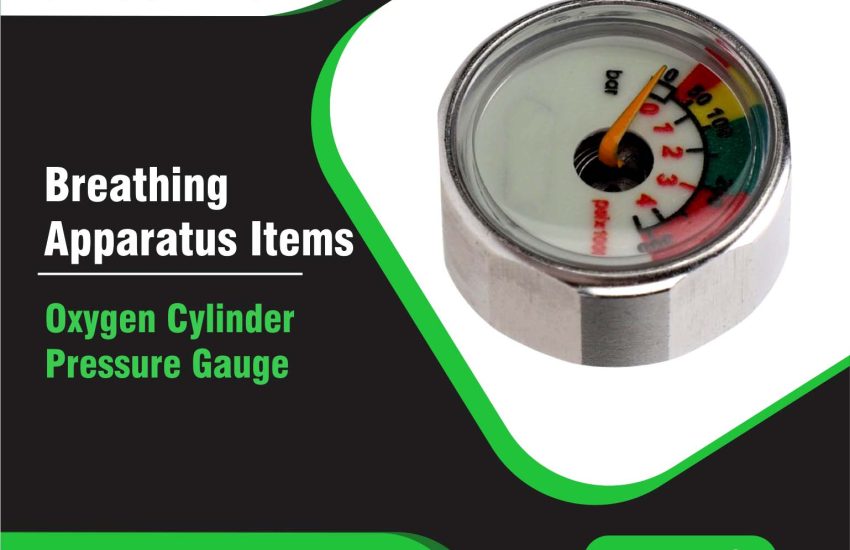An Oxygen Cylinder Pressure Gauge is a vital tool for measuring the pressure of oxygen gas stored in cylinders. It plays a key role in ensuring safety across medical, industrial, and other high-risk environments. Whether used in hospitals, firefighting, diving, or welding, this gauge helps maintain the necessary oxygen levels during critical situations.
Oxygen Cylinder Pressure Gauge: Key Specifications and Features
The Oxygen Cylinder Pressure Gauge is designed to provide accurate readings, allowing users to assess the remaining oxygen supply in cylinders. Here are its key specifications and features:
Material Construction
- Durable Housing: Typically made from stainless steel, the gauge resists corrosion and ensures long-lasting durability, even in harsh environments.
- Impact-Resistant Glass: The gauge is protected by impact-resistant glass or polycarbonate, which shields it from damage during rough handling.
- Weatherproof Design: Designed to withstand exposure to rain, moisture, and extreme temperatures, ensuring reliable performance in all conditions.
Pressure Range
- The gauge is available in a variety of pressure ranges, such as 0-3000 psi, 0-200 bar, or 0-20 MPa. These ranges make it compatible with most oxygen cylinders used in various industries.
- The gauge measures pressure in bars, psi, or MPa, offering flexibility based on user needs.
Accuracy and Calibration
- Oxygen Cylinder Pressure Gauges provide accurate readings, typically within ±1% to ±2% of the full scale. This ensures precise monitoring of oxygen levels.
- The gauges are calibrated according to industry standards, minimizing errors during critical applications or emergencies.
Dial and Readability
- The gauge has a large, easy-to-read dial with clear markings, enabling users to monitor oxygen levels even in low-light conditions.
- Some models feature dual scales, displaying pressure in both psi and bar, providing more flexibility to suit user preferences.
Connection and Mounting
- Designed to fit the standard oxygen cylinder valve, the gauge uses brass or stainless steel connections to prevent corrosion and ensure a secure fit.
- Many models come with screw threads or quick-connect fittings, simplifying installation and removal.
Why Choose an Oxygen Cylinder Pressure Gauge?
A reliable Oxygen Cylinder Pressure Gauge offers several key advantages, making it essential in environments where oxygen safety is critical. Here are the main benefits:
Accurate Monitoring of Oxygen Supply
- By providing real-time pressure readings, the gauge helps healthcare professionals and workers assess the remaining oxygen supply. This prevents unexpected shortages during critical procedures.
- Monitoring the pressure allows users to plan for oxygen refills and avoid disruptions, ensuring continuous oxygen availability when needed.
Enhanced Safety
- The gauge prevents overuse and underuse of oxygen cylinders, reducing the risk of accidents or hypoxia (oxygen deficiency) in environments where oxygen is essential.
- Medical professionals ensure patients receive the required oxygen flow, and firefighters can monitor their oxygen supply during hazardous operations.
Durability and Reliability
- With corrosion-resistant materials and impact-resistant features, the gauge performs reliably, even in industrial or outdoor environments. It can withstand harsh conditions, ensuring long-term durability and dependability.
User-Friendly Design
- The large, readable dial and dual pressure scales allow users to quickly interpret oxygen levels, improving response times in emergencies.
- The lightweight and ergonomic design make the gauge convenient to carry and use in various environments.
Applications of Oxygen Cylinder Pressure Gauge
The Oxygen Cylinder Pressure Gauge is essential in industries where oxygen is required for medical or operational purposes. Here are the primary applications:
Medical Use
- In hospitals and emergency medical services, the gauge ensures that oxygen cylinders are monitored closely, guaranteeing that patients receive the required oxygen during treatments and procedures.
- ICUs and surgical theaters rely on these gauges to ensure proper oxygen delivery in critical care environments.
Firefighting
- Firefighters use the oxygen cylinder pressure gauge to monitor oxygen levels in their self-contained breathing apparatus (SCBA). The gauge ensures a sufficient oxygen supply during firefighting and rescue operations.
Welding and Industrial Applications
- In industries like welding, cutting, and fabrication, the gauge ensures that workers have a continuous oxygen supply for high-pressure tasks, such as welding operations and gas cutting.
Diving and Underwater Exploration
- Divers rely on the oxygen cylinder pressure gauge to monitor oxygen levels in their tanks, ensuring they do not run out while underwater. The gauge is crucial for deep-sea and commercial diving operations where safety is paramount.
Chemical and Oil and Gas Industries
- The gauge is also used in chemical plants, oil rigs, and gas plants to monitor oxygen supplies for processes like combustion, welding, and other specialized industrial tasks.
Conclusion
The Oxygen Cylinder Pressure Gauge is an indispensable tool for ensuring the safety, reliability, and efficiency of oxygen use across various industries. Its durable construction, accurate readings, and user-friendly design make it essential for environments that require continuous oxygen monitoring, such as medical facilities, firefighting, welding, diving, and more. With its reliable performance and critical features, the Oxygen Cylinder Pressure Gauge plays a vital role in maintaining oxygen safety and ensuring smooth operations in high-risk environments.


